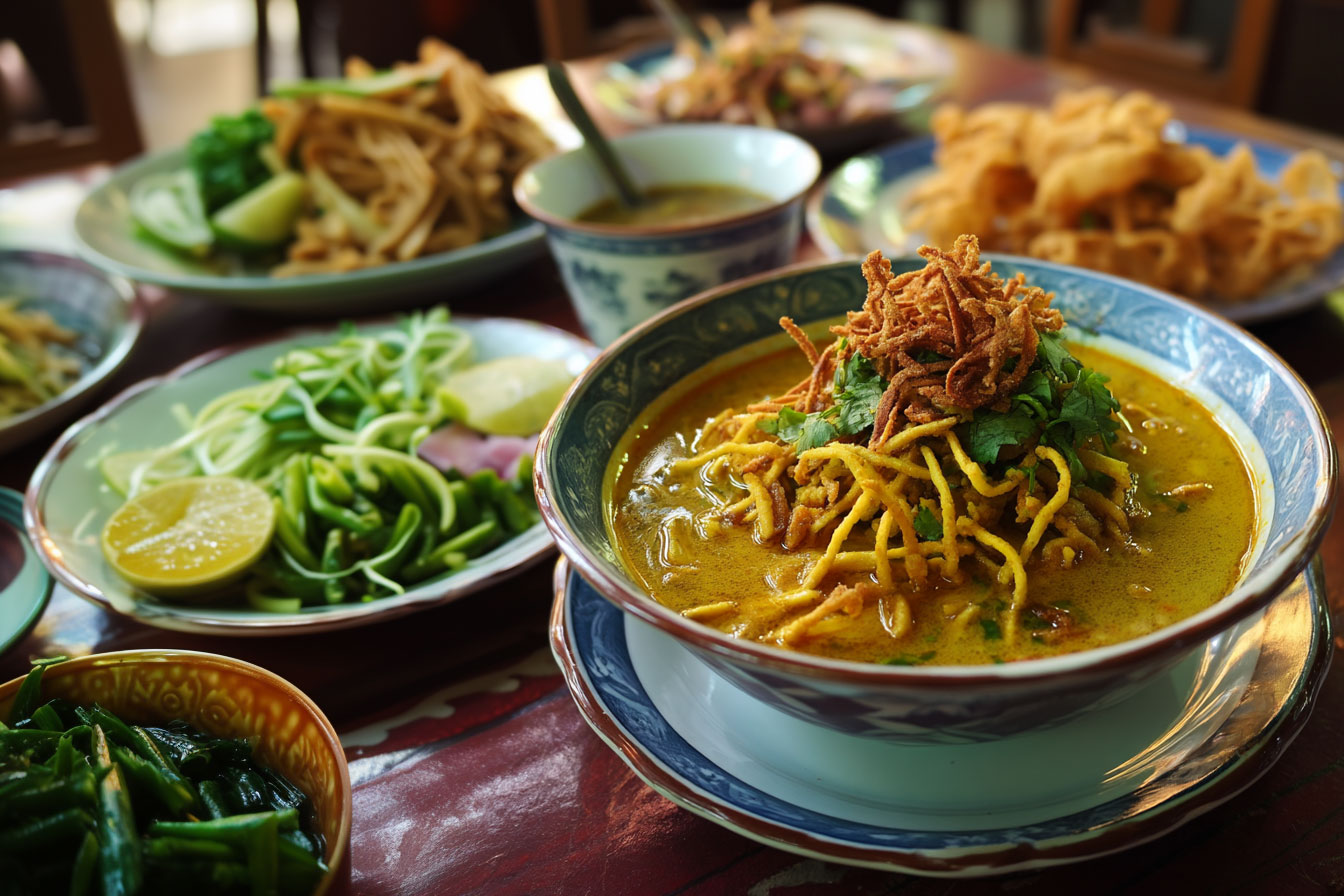Inside Chiang Mai’s Old City, the moat and brick ramparts enclose streets where Lanna traditions remain close to the surface. As lanterns glow over teakwood eaves and night blooming jasmine drifts on the air, an evening meal becomes more than dinner. It becomes a slow encounter with heritage, from tray style dining in a quiet courtyard to the lively clatter of grills at Chiang Mai Gate and the gentle hush beside the Ping River near Warorot Market. This guide follows a three stop route that combines ceremony, street culture, and riverfront calm, weaving together history and flavor in a few walkable hours.
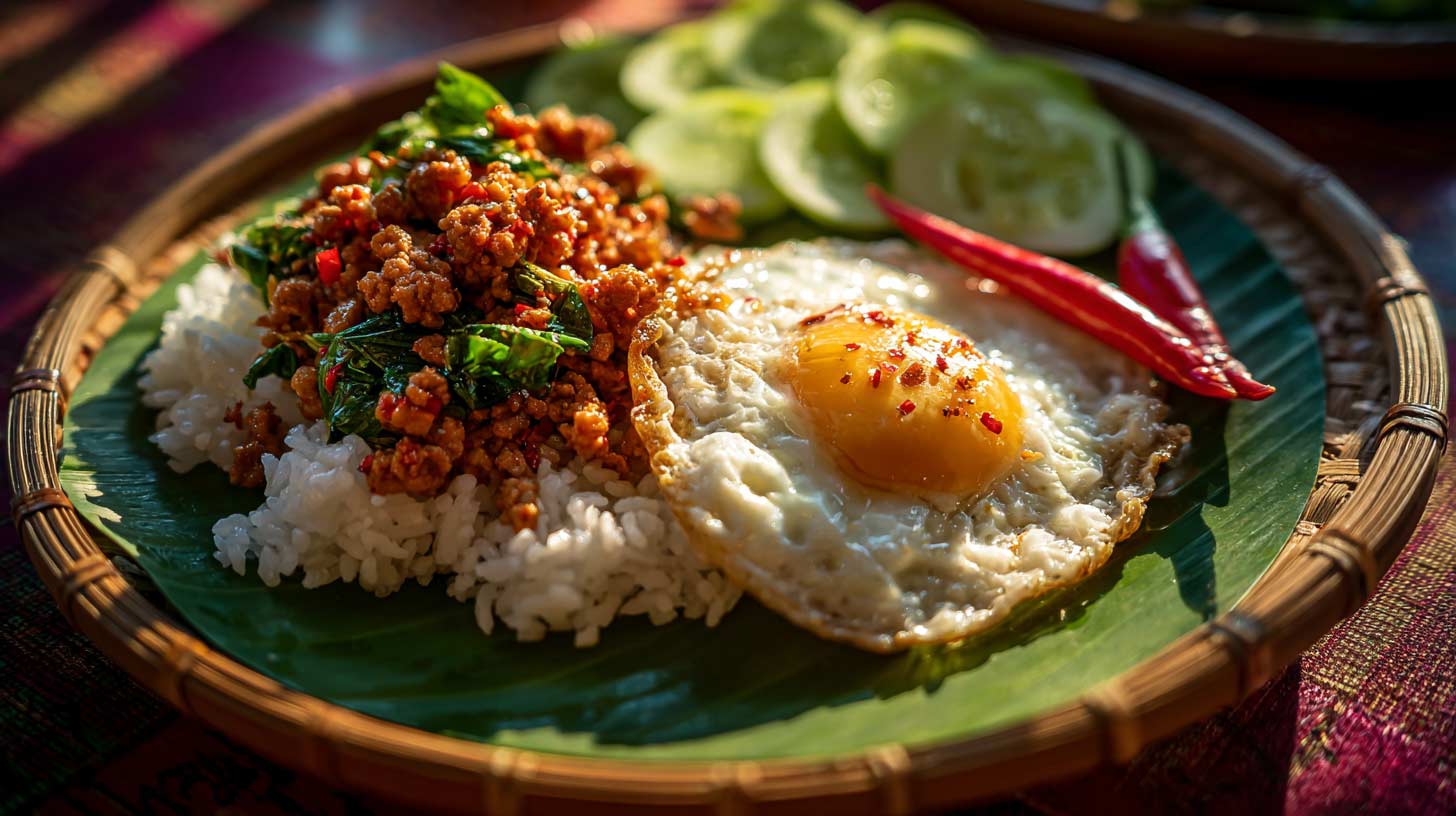
Stop 1: Old City Courtyard, Lanna Tray Meal
In a traditional Lanna style house set back from a narrow lane, low tables and floor cushions evoke home style hospitality. The setting is unhurried. Cicadas trill, a distant gong from a temple sounds, and lacquered trays arrive with small bowls arranged around a woven bamboo basket of warm sticky rice. The arrangement echoes the khantoke practice, a communal way of serving that centers on sharing, conversation, and balance of flavors.
Sticky Rice, The Meal’s Center
Sticky rice, or khao niao, is the anchor of Northern Thai dining. Pinched by hand and shaped into small bites, it becomes both staple and utensil, ready to pair with relishes, curries, and grilled items. The grain’s gentle sweetness and chew mirror the region’s agricultural rhythms, a reminder that Lanna, the land of a million rice fields, is rooted in paddies and seasons.
Gaeng Hang Lay, A Curry with Roots Across Borders
Gaeng hang lay appears in a deep earthen hue, clinging to slow simmered pork. Aromas of ginger, garlic, turmeric, and tamarind rise from the bowl. The recipe reflects centuries of exchange with Myanmar, and the Burmese name hints at its hearty character. The result is tender meat with a tangy glow and a gentle sweetness that complements sticky rice. In Lanna homes it accompanies gatherings, festival days, and family milestones, signaling welcome and generosity.
Nam Prik Ong, Chili Relish and Hospitality
Nam prik ong carries a bright red color from tomatoes and roasted chilies. Minced pork and aromatics create a rustic texture, somewhere between a relish and a sauce. The bowl rarely arrives alone. It is encircled by raw and blanched vegetables, curls of kab moo pork crackling, and wedges of cucumber. A small dab on a vegetable or a pinch of sticky rice brings a warm, tomato forward spice that builds slowly. Northern tables often include at least one nam prik, not as a side note but as the social heart of the meal where hands meet, dip, and share.
A few supporting dishes typically complete the tray. Light pickles refresh the palate, a clear soup with local greens steadies the spice, and aromatic herbs tie the set together. The tray presents contrasts that define Northern cuisine: heat balanced by herbs, richness lifted by acidity, and textures that range from crisp to silken. When the last grains of rice are used to gather the final traces from the bowls, the scene has done more than satisfy appetite. It has quieted the pace, introduced the region’s vocabulary of flavor, and prepared the way for the city’s night energy that waits outside the walls.
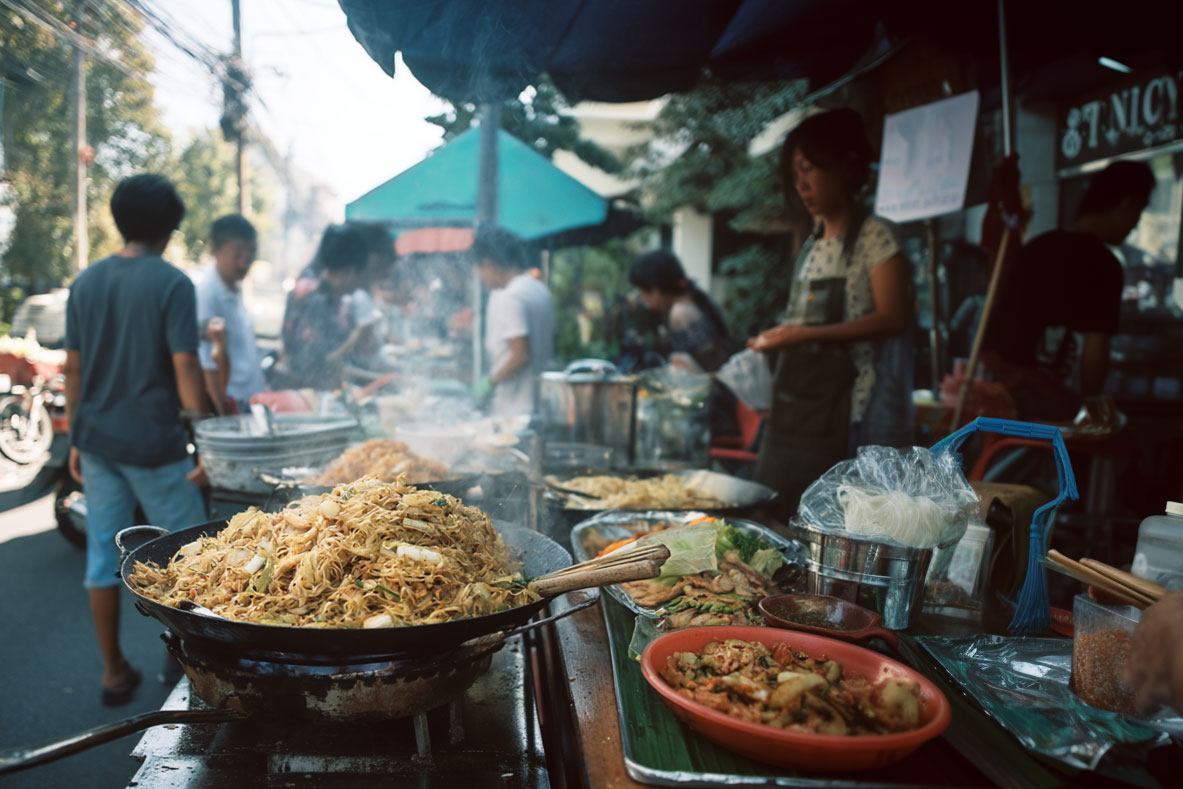
Stop 2: Chiang Mai Gate Night Market, Street Food Spectrum
South of the Old City, the brickwork of Chiang Mai Gate stands in warm light. Around it, a nightly food market springs to life with charcoal smoke, bright bulbs, and the steady rhythm of metal ladles on hot woks. Tables and stools appear wherever space allows. Families, students, office workers, and travelers share the same lanes, a democratic scene that defines the market’s charm.
Sai Ua, The Herbal Signature
Few items signal the North as clearly as sai ua, the coiled pork sausage flecked with lemongrass, chili, and makrut lime leaf. On the grill, the casing blisters and turns glossy, releasing a perfume that announces itself down the street. Sliced into coins and served with sticky rice, it becomes an ideal first taste at the gate, a compact summary of herbs and smoke.
Moo Ping and Quick Bites
Moo ping skewers baste over coals, caramelizing at the edges. A few baht buys a hot skewer tucked beside a small packet of sticky rice. That combination, eaten standing beneath the open sky, captures why Thai street food endures: immediacy, depth of flavor, and the pleasure of eating among others. Nearby, grills turn out pork neck, chicken wings, and squid; woks flash fry garlic and chilies for platefuls of greens or noodles; crepe and roti makers stretch and flip dough for soft desserts and crisp edged sweets.
Fruit Shakes and Roti for a Sweet Finish
Fresh fruit stands display towers of mango, pineapple, and watermelon. A mango shake, blended with ice and a hint of milk, cools spice and smoke from earlier bites. For dessert, the roti cart draws a crowd. A banana and egg roti sears in butter until golden, then receives a ribbon of condensed milk. It is a Thai Muslim inspired sweet that has become a market favorite throughout the country. Small squares are handed over in a paper tray, still hot, crisp at the edges, and soft within.
At Chiang Mai Gate, the backdrop matters as much as the food. The gate has stood through caravans, conflicts, and calm. Today it hosts nightly scenes of conversation and appetite, a living square where the past’s brickwork holds up the present’s bright stalls. For many visitors, a stop here is the moment when the city’s friendliness becomes tangible, table by table and skewer by skewer.
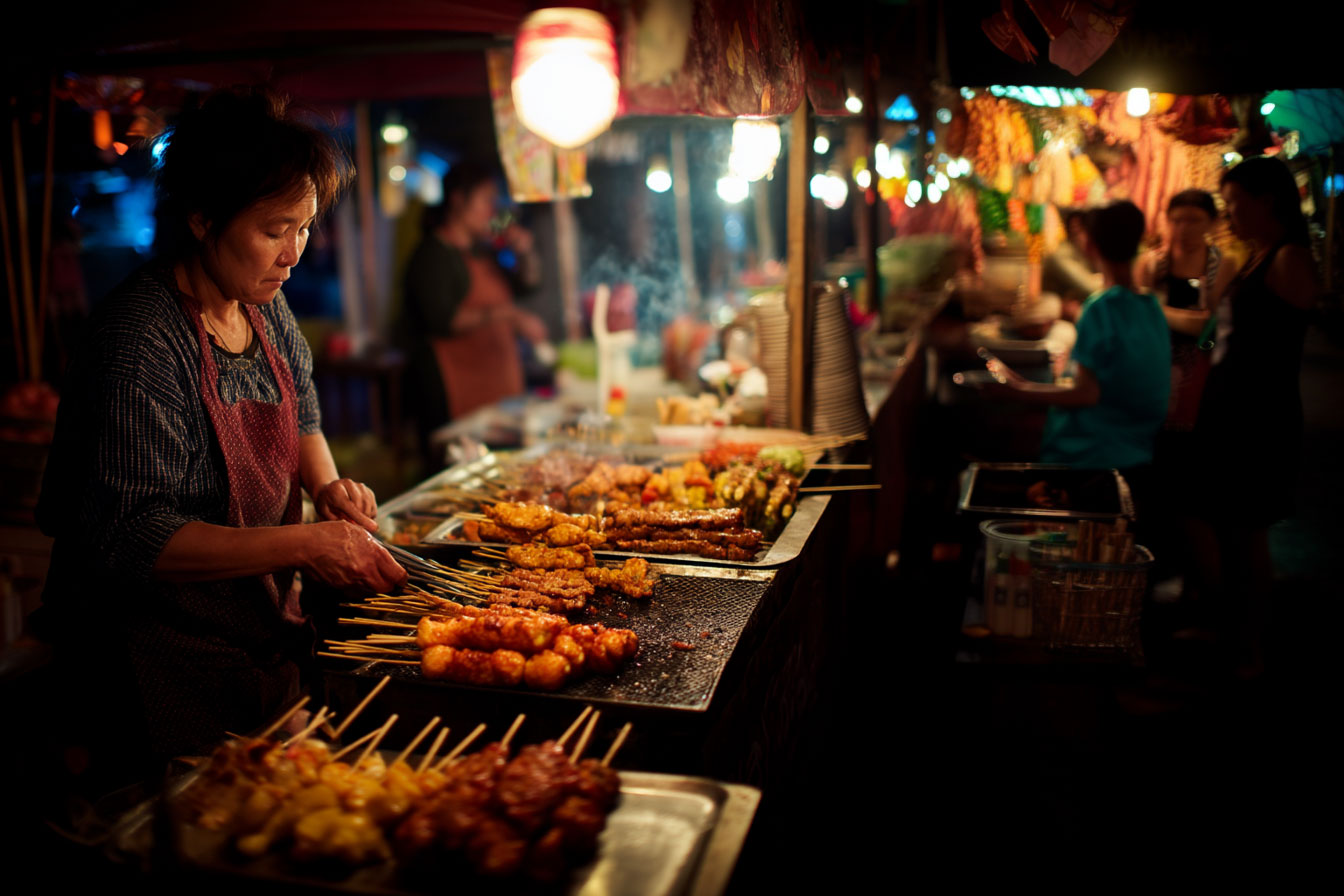
Stop 3: Warorot Market by Night and the Gentle Ping
East of the Old City, the route continues to Warorot Market, also known as Kad Luang. By day, Warorot is the city’s great emporium of textiles, produce, and household goods. By night, pockets of vendors remain active around the main buildings, and the nearby Ton Lamyai flower market sends fragrance into the streets. The market’s riverine setting speaks to trade history. Chinese merchant houses once anchored the area, goods arrived by boat, and the Ping River kept the city connected to the wider North.
Late Night Bites and Classics
In the glow of bulbs strung above narrow lanes, grills and steamers continue their work. Another version of sai ua releases a woodier smoke, reminding that family recipes vary from stall to stall. A counter offers khao tom and jok, gentle rice soups favored late at night. On one corner, a vendor pours steaming nam tao hu sweet soy milk into cups and hands over crisp patonggo crullers for dipping. The pairing is simple and restorative, a Thai Chinese comfort that suits the hour and the slow pace near the riverbank.
Just across the road, florists at Ton Lamyai weave jasmine garlands and stack roses for temple offerings. The blend of night flowers and grilling herbs is a distinctly Chiang Mai fragrance. The river lies a block away, and broad steps provide a place to sit, sip warm soy milk, and watch reflections slip along the surface. Bridges show their silhouettes, and music from a radio carries softly on the air. The scene is quieter than the gate, yet equally local, a late hour portrait of the city at ease.
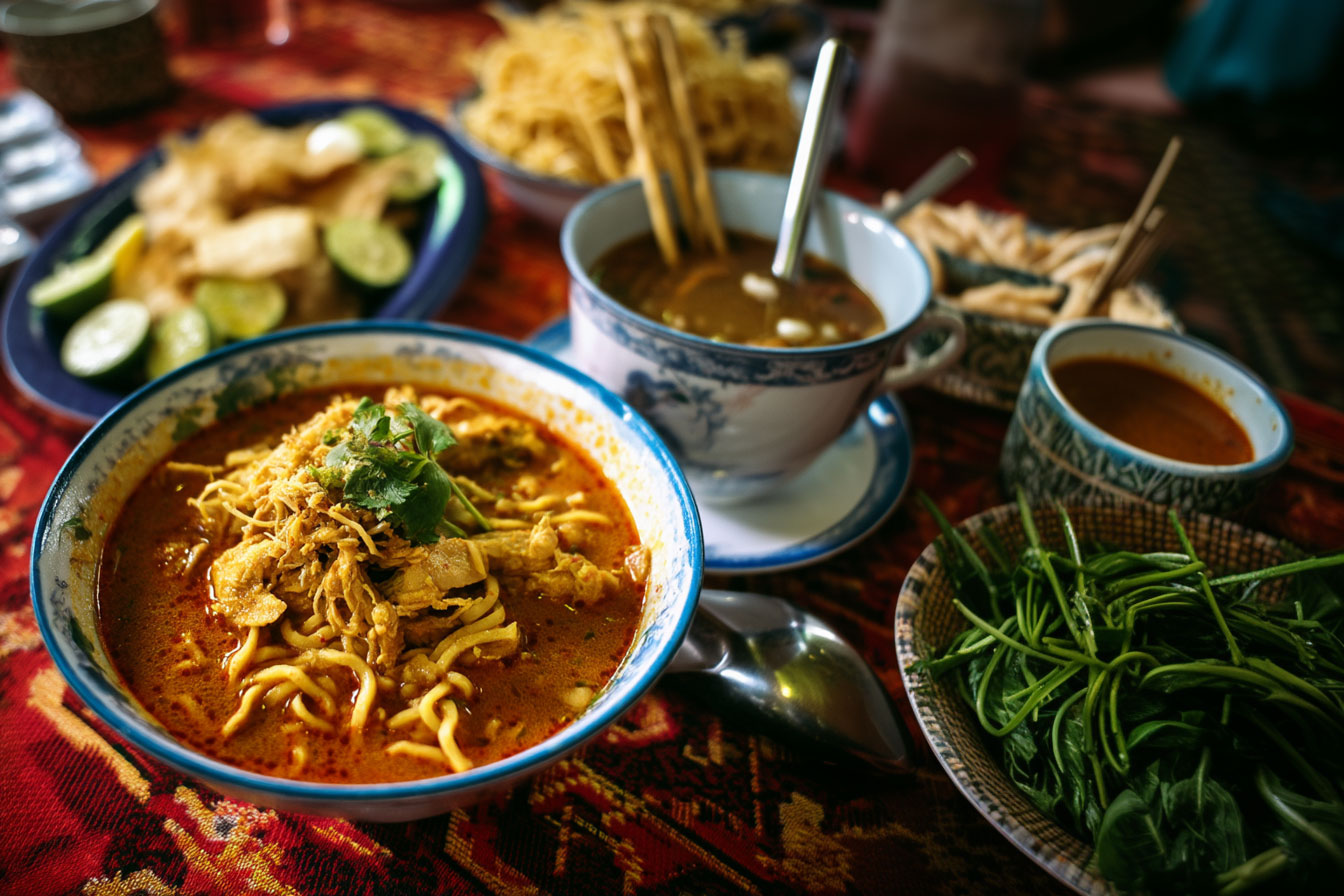
Practical Route, Timing, and Etiquette
- Suggested order – begin with a courtyard tray meal inside the Old City, move south to Chiang Mai Gate Night Market for street food variety, then continue east to Warorot Market and the river for a gentle close.
- Timing – start around 6.30 to 7.00 pm for the courtyard meal, arrive at Chiang Mai Gate between 7.30 and 9.00 pm when grills are in full swing, reach Warorot around 9.30 to 10.30 pm to catch late night vendors and the open flower market.
- Transport – walking is feasible if staying inside the Old City. Otherwise, use songthaews or tuk tuks for short hops between stops.
- How to order – most stalls display items plainly. Point and confirm quantity, then pay when served. Keep small bills and coins on hand for speed and courtesy.
- Temple attire reminder – if visiting courtyards attached to active temples, cover shoulders and knees, remove shoes where required, and keep voices low.
- Food safety – choose busy stalls with steady turnover. Ask for items cooked to order if possible, and carry bottled water for hot evenings.
- Waste and respect – use bins, avoid feeding stray animals, and return dishes and baskets to vendors to help keep the markets tidy.
Lanna Context, Flavors, and Pairings
Northern Thai food often balances herbal brightness, chili warmth, and gentle sourness against the steadying presence of sticky rice. Dishes favor grilling, roasting, and slow simmering. Coconut milk appears less often than in central Thai curries. Burmese and Chinese influences are easy to taste, especially in spice choices such as turmeric and cumin for hang lay, and in late night comforts like soy milk and porridge. The trio of stops in this route illustrates those layers clearly. The courtyard tray meal speaks to ceremony and household traditions, the gate market captures night energy and ingenuity, and the riverfront reflects the trade lines that shaped the city’s pantry.
Menu Highlights to Seek
- Sticky rice with relishes and grilled items.
- Gaeng hang lay pork curry, tangy and ginger forward.
- Nam prik ong tomato and chili relish with cucumber and kab moo.
- Sai ua Chiang Mai sausage, sliced and served with herbs.
- Moo ping skewers with a small packet of sticky rice.
- Fresh fruit shakes, especially mango during peak season.
- Banana roti with condensed milk.
- Nam tao hu hot soy milk with patonggo for dipping.
What is the best day to follow this route?
Any evening works, although weekends bring larger crowds at Chiang Mai Gate. Warorot’s surrounding night stalls operate most nights, and the flower market runs late, which makes the river stop reliable even after 10.00 pm.
Is the food spicy?
Heat levels vary. Nam prik relishes and grilled sausages carry moderate warmth, while gaeng hang lay tends to be aromatic rather than fiery. Vendors can often adjust or suggest milder choices.
Can vegetarians enjoy this route?
Yes. Seek grilled mushrooms, stir fried greens, vegetable soups, roti with banana or egg free versions, fruit shakes, and soy milk. Some stalls prepare nam prik without minced pork; ask before ordering.
How much cash is needed?
Street food prices remain accessible. A few hundred baht covers snacks and drinks at the gate and the river. Courtyard tray meals vary by venue and set; confirm before ordering.
More to taste and see
Conclusion, A Night That Tastes Like Chiang Mai
Within a short radius, Chiang Mai offers a sequence that feels complete. A serene courtyard reveals the heart of Lanna hospitality, a market beside a centuries old gate delivers the city’s playful appetite, and a riverside pause near Warorot returns the evening to calm. Together, the three stops trace a simple arc from tradition to bustle to reflection. For visitors, this route is an invitation to savor the city at human pace, one small bowl, one skewer, and one warm cup at a time.
